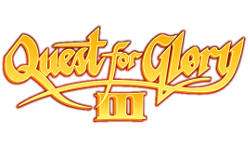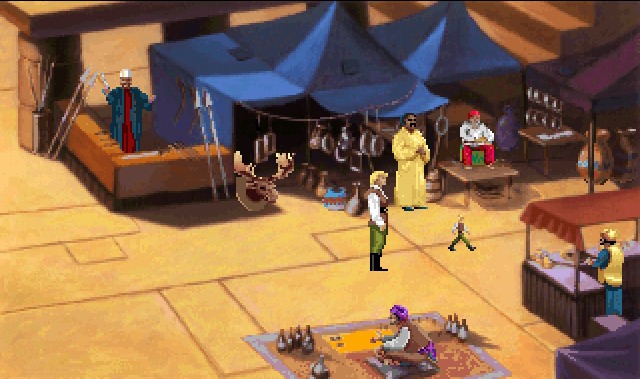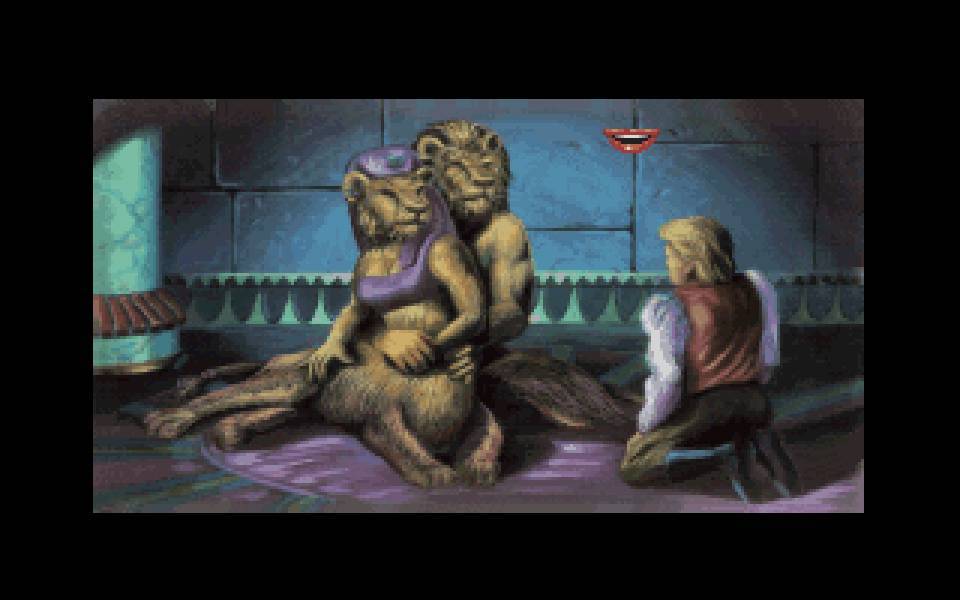|
|

|
PLATFORM
|
PC
|
BATTLE SYSTEM
|

|
INTERACTION
|

|
ORIGINALITY
|

|
STORY
|

|
MUSIC & SOUND
|

|
VISUALS
|

|
CHALLENGE
|
Moderate
|
COMPLETION TIME
|
Less than 20 Hours
|
|
OVERALL

|
+ Fills a necessary space in the series
+ An interesting setting and backdrop
+ VGA graphics are good...
- ... but may detract from overall presentation
- Ending is very abrupt
|
Click here for scoring definitions
|
|
|
It's good to be the Hero. After saving the Barony of Spielburg from Baba Yaga's curse and defeating the evil sorceror who sought to rain havoc upon the southern deserts, a few months of life as the adopted son of a Sultan is quite nice. Duty calls, however, in Quest for Glory III: Wages of War. There's trouble brewing in the far-off land of Fricana, home to your friend and mentor Rakeesh the liontaur paladin, and they need a Hero to keep the peace.
Wages of War wasn't originally a planned part of its series, but was created to help bridge the space between Trial by Fire and Shadows of Darkness because the developers feared the difficulty curve would be too steep. Because of this, Wages of War feels comparable to the middle movies of some famous series, like The Empire Strikes Back or Temple of Doom. It was used as a testing ground for new programming techniques and interface design, some of which worked and some of which did not.
For the basics of the story, we have the titular war that's about to explode across Fricana. The Simbani people of the savannah claim that the leopardmen have stolen their sacred spear, and demand retribution. The leopardmen say the Simbani stole their magic drum. The fact that both sides actually have the contraband in question is making reconciliation tricky. The king of the liontaurs thinks that all humans are misguided fools — including the Hero — so there's little help from that quarter. And in some far-off corner of the realm, demons plot. Unfortunately, it all could have been much more exciting and involved than it actually was. The ending scene in particular cuts off so abruptly that it may leave the player staring at the screen for a moment, befuddled, before the credits pop in.
This game offers the broadest setting of its series, with a vast savannah and jungle waiting to be explored. There's the distinctly Egyptian city of the liontaurs, the mostly Masai village of the savannah people, and the hidden jungle hamlet of the shapeshifting leopardmen. There's a massive, mystical tree and a lost city full of marauding ape-men. And then there's a whole lot of empty space in-between. Compared to the games both before and after, Wages of War feels less than it should be. Events are spaced widely to accommodate travel times, and side quests are few and far between. More needed to be done to support some of the secondary characters, or at least to help explain why so many of them teleported in to help the Hero in the final level.
 An Forda and Son, purveyors of classic junk and recycled props.
An Forda and Son, purveyors of classic junk and recycled props.
|
|
This was the first game in the series to be made with VGA graphics from the get-go, and it may have gone to some people's heads. Instead of the close-in, intimate views of scenery that the player has in the first two games, Wages of War tends to pull the zoom far out, offering large cityscapes and map-like backdrops, plus numerous splash pages to stand in for particular scenes or conversations. Another side effect of the VGA conversion is that character models have lost their cartoonishly animated features in favor of a more realistic approach, which doesn't necessarily work well when many of the NPCs are so fantastical in design. In terms of raw graphics, it's a big step forward, but for presentation it actually feels like a step back when compared to Trial by Fire (EGA graphics notwithstanding).
Likewise, the battle system has suffered a bit. Instead of employing the Hero's regular game sprite, as the previous game had, Wages of War uses what looks like a style of animated portrait for both hero and monster. It's not obvious how the buttons make him move or whether a hit's landed properly, and on most modern computers there may also be lag and timer issues messing with things. For that same reason, the Hero's stamina gauge drains away in battle like someone pulled a plug out of the bottom.
Battles can be avoided or escaped, though it may require running through anywhere between three and three dozen screens of savannah before the pursuit ends. Thieves and Magic-Users needn't fight anything for most of the game, but Wages of War does give a variety of social handicaps to its less physically oriented heroes. Magic is generally frowned upon by the liontaurs and Simbani, while theft is met with some idiosyncratic concepts of justice, so it's definitely easier and more straightforward to play as a Fighter or Paladin. Magic-Users have access to the magic staff side quest, and Fighters have the trials of the Simbani warriors, both of which prove crucial to the game at different points. Thieves have to make do with two basic burglaries (plot-relevant, for a change), which are frankly kind of bland except for the patroling panther in the second one.
 No, no! Don't fight the kitty!
No, no! Don't fight the kitty!
|
|
Wages of War fills in its empty space with a decent soundtrack, with a heavy preference for drums and jungle beats. It's a good backdrop for the adventure and glory, and certainly the best music to appear in the series thus far.
The biggest change of all has to be the interface. The first two Quest for Glory games used a text parser, and to good effect, but with the move to the VGA generation all Sierra games began using a point-and-click icon interface. In many ways it's more convenient, but it still feels like the genre lost something in the transition. It's harder to hide the clues when all the player needs to do is click around the scenery like a madman, for example, and the game forces the player to go through nested dialogue boxes in order to find or revisit important topics of conversation. As with many parts of this game, it's a good move forward but it could have been done better.
There is one addition this game makes to the series that is unequivocally for the good. It updates an automatic save file every time battle is imminent, as well as at crucial points in the story where time is of the essence. Much progress was not lost during this playthrough because of this one feature, and it's good to see that it survived to the next game of the series as well.
 Cuddle the kitty, instead!
Cuddle the kitty, instead!
|
|
Like those movies I mentioned above, Quest for Glory III: Wages of War isn't a bad experience by any means, but it is eclipsed by the games that precede and succeed it. It's an interstitial title, filling in the space between Trial by Fire and Shadows of Darkness handily but not quite satisfactorily. It may be the least of the series in many ways, but that doesn't make it a bad game — merely an underwhelming one. There's always the next adventure!
AOI.
(Kudos to anyone who knows what the above line references. No cheating!)
Review Archives
|









